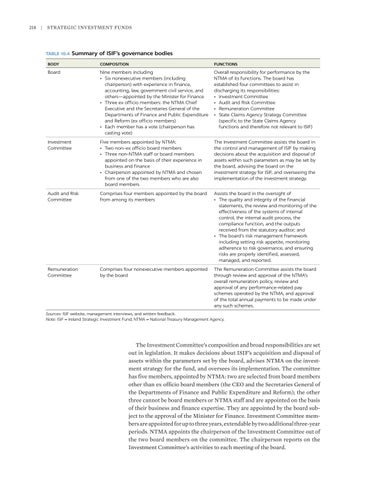218
| Strategic Investment Funds
TABLE 10.4
Summary of ISIF’s governance bodies
BODY
COMPOSITION
FUNCTIONS
Board
Nine members including • Six nonexecutive members (including chairperson) with experience in finance, accounting, law, government civil service, and others—appointed by the Minister for Finance • Three ex officio members: the NTMA Chief Executive and the Secretaries General of the Departments of Finance and Public Expenditure and Reform (ex officio members) • Each member has a vote (chairperson has casting vote)
Overall responsibility for performance by the NTMA of its functions. The board has established four committees to assist in discharging its responsibilities: • Investment Committee • Audit and Risk Committee • Remuneration Committee • State Claims Agency Strategy Committee (specific to the State Claims Agency functions and therefore not relevant to ISIF)
Investment Committee
Five members appointed by NTMA: • Two non–ex officio board members • Three non-NTMA staff or board members appointed on the basis of their experience in business and finance • Chairperson appointed by NTMA and chosen from one of the two members who are also board members
The Investment Committee assists the board in the control and management of ISIF by making decisions about the acquisition and disposal of assets within such parameters as may be set by the board, advising the board on the investment strategy for ISIF, and overseeing the implementation of the investment strategy.
Audit and Risk Committee
Comprises four members appointed by the board from among its members
Assists the board in the oversight of • The quality and integrity of the financial statements, the review and monitoring of the effectiveness of the systems of internal control, the internal audit process, the compliance function, and the outputs received from the statutory auditor; and • The board’s risk management framework including setting risk appetite, monitoring adherence to risk governance, and ensuring risks are properly identified, assessed, managed, and reported.
Remuneration Committee
Comprises four nonexecutive members appointed by the board
The Remuneration Committee assists the board through review and approval of the NTMA’s overall remuneration policy, review and approval of any performance-related pay schemes operated by the NTMA, and approval of the total annual payments to be made under any such schemes.
Sources: ISIF website, management interviews, and written feedback. Note: ISIF = Ireland Strategic Investment Fund; NTMA = National Treasury Management Agency.
The Investment Committee’s composition and broad responsibilities are set out in legislation. It makes decisions about ISIF’s acquisition and disposal of assets within the parameters set by the board, advises NTMA on the investment strategy for the fund, and oversees its implementation. The committee has five members, appointed by NTMA: two are selected from board members other than ex officio board members (the CEO and the Secretaries General of the Departments of Finance and Public Expenditure and Reform); the other three cannot be board members or NTMA staff and are appointed on the basis of their business and finance expertise. They are appointed by the board subject to the approval of the Minister for Finance. Investment Committee members are appointed for up to three years, extendable by two additional three-year periods. NTMA appoints the chairperson of the Investment Committee out of the two board members on the committee. The chairperson reports on the Investment Committee’s activities to each meeting of the board.

